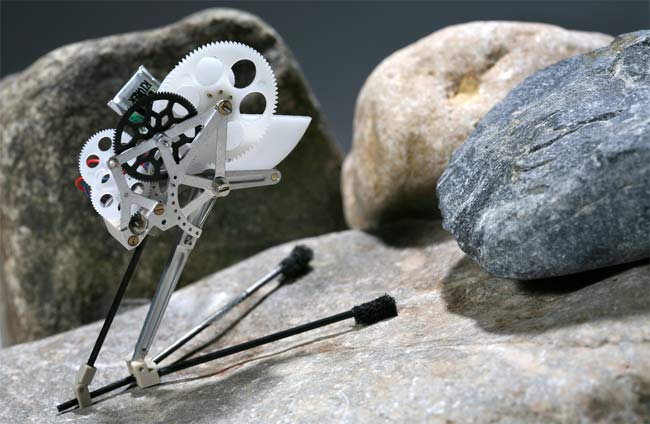Amazing Robot Jumps Like Grasshopper

Looking like a gear-head grasshopper, a new robot can jump distances more than 27 times its body length. The contraption, about the size of a locust and weighing only about a quarter of an ounce (7 grams), could aid in search and rescue operations and explore rough terrain.
Invented by researchers at the Laboratory of Intelligent Systems at the Ecole Polytechnique Fédérale de Lausanne (EPFL) in Switzerland, the robot can hop 10 times farther for its size and weight than any existing jumping robot.
"We are about in the same jumping performance of a locust," said EPFL graduate student Mirko Kovac, who helped design the robot. "The desert locust can jump up to 1 meter in distance and is around 3 centimeters long. In order to obtain such very high jumping performance, we actually analyzed locusts and applied the same biomechanical design principles."
The robot uses a similar mechanism to store jumping energy as fleas, locusts, grasshoppers and frogs. It relies on a tiny battery and motor to charge two springs that can quickly release energy to achieve very powerful jumps and very quick accelerations. After charging for 3 seconds, it can make up to 320 jumps.
"This biomimetic form of jumping is unique because it allows micro-robots to travel over many types of rough terrain where no other walking or wheeled robot could go," said EPFL researcher Dario Floreano. "These tiny jumping robots could be fitted with solar cells to recharge between jumps and deployed in swarms for extended exploration of remote areas on Earth or on other planets."
Kovac unveiled the leaper at the IEEE International Conference on Robotics and Automation May 21 in Pasadena, California.
- Video: Hopper 'Bot Prototype
- Vote for your favorite Real Robots
- Image Gallery: Cutting-Edge Robots
Get the world’s most fascinating discoveries delivered straight to your inbox.



